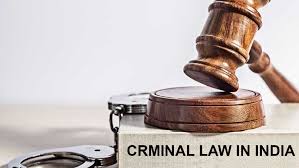There was no criminal law in Ancient time. The society was uncivilised. Neither the life nor the property was safe in that society. At that time people believed only on one thing a life for a life. Time changed and the people made law based upon their religion. They segregated law according to their Holy book and their culture.
In the antiquated Hindu law, it was the obligation of the ruler to rebuff the guilty party. The Hindu law-providers didn’t explicitly recognize common wrong wrongdoing, still, the distinction in punishments and strategy which they have recommended shows that they plainly acknowledged how the criminal part of a contrasted from its common regard. After the triumph of the nation by Muslims Mohammedan criminal law was presented in our nation, and the Indian Courts applied Mohammedan criminal law in the organization of equity.
The Indian Penal Code which was introduced in 1860 is enforceable in part of Indian Territory. It followed various England Common Law theories and concepts that were changed from time to time. One of the distinctive characteristics of the Indian Penal Code is that it follows the country’s general code of criminal law. This includes the full spectrum of crimes. It is about security. The people from accidents were linked to the human body, Property and Reputation. Some common crimes such as murder, abduction, rape, robbery, stealing, etc. have been punishable under the various sections provided for in the Indian Penal Code, whereas the Indian Penal Code has also covered various actions committed in good faith, with or without consent of negligence, cruelty, etc.
In addition to these, some of the other state-related offences pursuant to Section 121, Government pursuant to Section 121A, public tranquility and public disturbance pursuant to Sections 149 and 268 respectively, social structures such as marriage pursuant to Section 494, public morality pursuant to Section 295 and against morals pursuant to Section 292 were made punishable under the Indian Penal Code.
It applies in the entire Indian Territory except in Jammu Kashmir. The jurisdiction of the territories is founded on the principle that all crimes are local. Therefore, the provisions of the Indian Penal Code extend to all persons including foreigners on the Indian soil. Nevertheless, only presidents, governors and foreign sovereigns and ambassadors were exempt from criminal liability for all acts under the colour of their office.
The Indian Penal Code also has extra territorial authority in the sense that it applies only outside of Indian Territory to all Indian nationals. Indian Penal Code jurisdiction has also applied to any person on a ship or aircraft registered in India because the recognition of such jurisdiction is based on the principle that each nation has the right to control and rule its own jurisdiction.
In short, the Indian Penal Code is incredibly bright in terms of regulating any person’s crime and crimes, whether in the Indian territories or elsewhere in the world.
Criminal Procedure Code
The Code of Criminal Procedure cannot be distinguished from any of the country’s penal legislation. If Significant Penal Law is a major means of protecting society, a key method for achieving and implementing Significant Law is Procedural Criminal Law. When the Code of Criminal Procedure came into effect in 1973, the 1898 Code of Criminal Procedure was in effect. Several changes were introduced in this new code, the main object of which was to isolate the judiciary from the Executive. There are 37 chapters, 484 section, and two Schedules in the Criminal Procedure Code, 1973. There is the description of the crimes in this First Schedule, and other elements have been included in the Second Schedules. Code of Criminal Procedure, 1973 applies to India as a whole. (Section 1 of the Code of Criminal Procedure, Short title, scope and beginning) This shall come into force on the first day of April 1974.
Evidence Law
Evidence law is the branch of law concerned with the rules and methods by which evidence is admitted and used in a legal trial. These rules set out what type of evidence can be admitted for consideration by a judge or jury in a trial. Evidence law also concerns the type of objections that can be raised to certain evidence being admitted, such as hearsay, illegally-obtained evidence, or a privilege that prevents the evidence in question from being admissible at trial.
Evidence law deals with the laws and procedures by which proof is accepted and used in a legal case. Such rules stipulate what form of evidence a judge or jury in a court can accept for consideration. Evidence law also includes the form of challenges that may be posed to the inclusion of such facts, such as hearsay, evidence collected unlawfully or a right that prohibits the proof in question from being admissible at court.
Hierarchy of Criminal Courts
The hierarchy of the Criminal Courts in India is as follows:
The Supreme Court of India – The Indian Supreme Court, which is India’s highest court, was created in accordance with Article 124 of Part V and Chapter IV of the Indian Constitution.
The High Courts of India – the high courts are at the rank of second level. It is governed by Article 141 of India’s Constitution, and is bound by the Apex Court’s judgment.
Lower Courts of India have been classified as follows.
A) Metropolitan Courts
B) Sessions Court
C) Chief Metropolitan Magistrate
D) First Class Metropolitan Magistrate
E) District Courts
F) Sessions Court
G) First Class Judicial Magistrate
H) Second Class Judicial Magistrate
I) Executive Magistrate
Written By:- Shireen Sultana


अत्यंत महत्वपूर्ण जानकारी प्राप्त हुई।